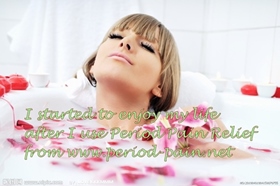Menstrual Cramps Period Pain and PMS
Every 100 Women around 80 have menstrual cramps period pain and PMS
What are menstrual cramps period pain or PMS?
Menstruation is a monthly occurrence for women in which the body sheds the lining of the uterus (womb), which is then passed through a small opening in the cervix and out through the vaginal canal. Some pain, cramping, and discomfort during menstrual periods is normal.
However, excessive pain that causes you to regularly miss work or education is not normal.
The medical term for painful menstruation is dysmenorrhea. Primary dysmenorrhea occurs in women who experience pain just before and during menstruation, but who are otherwise healthy.
Women who have had normal periods that later become painful may have secondary dysmenorrhea. This condition is usually accompanied by a problem affecting the uterus or other pelvic organs.

Why period cramps pain happen?
During each menstrual period, if there is no sperm to fertilize the egg, the uterus contracts to expel its lining. This process is driven by the release of hormone-like substances called prostaglandins, which is associated with pain and in higher levels.
These uterine contractions cause most of the pain felt during menstrual cramps because the contractions inhibit blood flow to the lining of the uterus (the endometrium).
In addition, substances known as leukotriene are also elevated during menstruation, and they may be the cause of menstrual cramps.
Women with delayed sleep phase syndrome are more likely to report irregular menstrual cycles and premenstrual symptoms, as well as menstrual cramps.
Several underlying medical conditions are also capable of causing menstrual cramps. These include:
- Endometriosis - the tissue that lines the uterus develops outside the uterus
- Uterine fibroids - noncancerous tumors and growths in the wall of the uterus
- Adenomyosis - the tissue that lines your uterus grows into the muscular walls of the uterus
- Pelvic inflammatory disease (PID) - a sexually transmitted infection caused by a bacterium
- Cervical stenosis - the opening of the cervix is small and limits menstrual flow.
How to avoid menstrual cramps period pain and PMS
Eat healthy, don't drink or eat cold or spicy food when you are in period.
Take good rest, don't work too hard, have enough sleep and don’t get tired before your period start.
Keep warm, don't touch cold water.
Keep calm and happy, don't be upset or stressed out.
Use healthy medicine if necessary, don't take too many pain-killers, natural medicine like herbs is more useful and less harm to your body for painful menstruation.